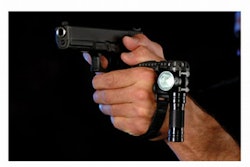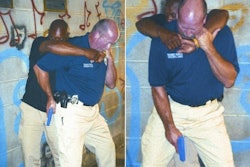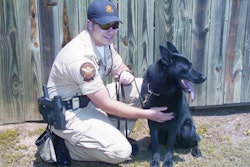Just before 11 a.m. on Saturday morning, March 17, 2004, a call went out: A man at the Miller Community Center on Seattle's Capitol Hill was armed with a shotgun. Shots had been fired and someone was down.
Two blocks from the scene, Officer Mike McDonald and Officer Richard Pruitt of the Seattle Police Department were directing traffic around an accident. A 16-year veteran of the Seattle PD and an acting sergeant, Pruitt didn't know what to make of the call.
Gunshots weren't common in this part of the neighborhood and, from his close proximity, Pruitt was reasonably sure that he would've heard shots fired. All the same, he knew the dangers of such assumptions and rolled to the location with officer safety at the forefront of his mind.
Unwanted Attention
In recent days, the community center had served as a makeshift evacuation center for some 40 victims who had made the place their home in the aftermath of a large apartment fire. On this day, the Red Cross announced that they'd arranged for permanent housing for many of the evacuees.
Among their number was 31-year-old Dori Cordova, a single mother with a 10-year-old son. Unfortunately for Cordova, she had recently garnered the attentions of another displaced victim, Lawrence Owens, 43, and had only that morning told Owens that she and her son would be relocating without him. Cordova had learned that Owens had a violent past, and her maternal instincts had led her to tell Owens in no uncertain terms that she did not want him in her life or her son's life.
Owens, a Class 3 convicted rapist, had not taken the news well.
Open Ammo
The two officers parked in the street just southwest of the community center and exited their cars. McDonald had been with the squad for four years, but Pruitt had only recently transferred back after having worked a variety of other assignments. Neither had had much contact with one another during the intervening time and there was little time for introductions.
They simply started down an exterior staircase together. As they made their descent, the officers believed that the call must have been a hoax. There was simply no screaming, no yelling, nothing to suggest that there was anything other than peace this Saturday morning at the community center. But they changed their minds as they looked over a hedge at the base of the stairs.
A woman's body lay on the landing, a large duffel bag nearby. As Pruitt made his way to check on the woman's condition, McDonald took cover between the staircase and the front doors of the community center.
Checking for a pulse on the woman was a formality. Pruitt knew that Dori Cordova was dead. Three gaping holes were in her chest cavity, and steam was still rising from her body. The shooting had preceded the officers' arrival by mere seconds.
Glancing inside the abandoned duffel bag next to the victim's body, Pruitt took a quick inventory: open boxes of shotgun ammunition.
Not good. That means he's got extra ammunition, Pruitt thought.
McDonald became aware of a man's presence just eight feet beyond the pane glass window. Knowing that there was an armed suspect still in the immediate vicinity and concerned for the man's welfare, McDonald started to yell, "Hey, get out of th...! "
McDonald never finished his command. He saw that the man was reloading a shotgun.
At the sound of McDonald's voice, Pruitt reflexively raised his Glock in the direction that his partner's speech had been directed. He looked up to see a large black male just beyond the glass, staring down at him, a waist level shotgun barrel pointed at his head. Involuntarily flinching, Pruitt closed his eyes in anticipation of the shotgun blast that would surely disintegrate the window and kill him. But the gunman did not fire.
Don't Come in Here
McDonald was crouched on the ground. From his perspective, the 6-foot, 3-inch, 280-pound gunman loomed ominously over him. The gunman held the barrel of his sawed-off shotgun level with Pruitt's head as he reloaded, but his eyes and statements were aimed directly at McDonald, his words a flat, eerie monotone.
"Don't come in here."
But there was no shot, no shattering of glass.
McDonald aimed his sidearm at the man, repeatedly yelling for the man to drop the shotgun. But the man simply stared at him and continued reloading. McDonald, who was accustomed to receiving at least marginal compliance from most suspects, particularly when they had guns pointed at them, couldn't understand why the man wasn't responding to his orders.
"Don't come in." The man warned again, as he slid shells into the magazine of his shotgun.
Pruitt considered the gun the man held. He knew that the man was well within its range of normal accuracy.
And both officers shared an unarticulated thought: Firing their guns might not have the desired effect. Bullet deflection was one concern, and any wire mesh reinforcing the glass could possibly fragment the window, effectively obscuring their view of the suspect inside, leaving them sitting ducks. Both officers had been warned repeatedly against firing through windshields, but when it came to the prospect of ballistic impact involving other types of glass barriers, they were largely ignorant. Neither took the shot.
Meanwhile, the man retreated into the community center and out of sight.
Rapid Intervention
Both of the officers knew that there were people in danger inside the building. But they didn't know where.
McDonald had recently gone through Rapid Intervention Training. While Pruitt had not actually attended the training, he had read up on the technique and philosophies behind it in preparation for a sergeant's exam. And with a SWAT E.T.A. of an hour, both knew that they were the only ones in a position to stop this man from killing others. They had to make an entry.
Pruitt propped open the door with the suspect's discarded duffel bag, offering a means of ingress for McDonald and himself as well as any who would be responding behind them. Then McDonald led the way into the building, attempting to relocate the suspect by visually slicing the pie as far to his left as he could without losing sight of the foyer or exposing himself.
The officers hugged the wall just inside the door, moving toward an interior stairwell where they'd last seen the suspect. Pruitt had watched the suspect step onto the bottom stair and believed that he may have gone upstairs. McDonald believed that he may have doubled back behind the stairwell that shadowed recessed restrooms.
McDonald had advanced several feet when he saw the man coming down the stairs, the shotgun in tow.
"Suspect!" McDonald yelled, warning his partner.
Both officers leveled their .40 caliber Glocks at the man. Just as he put pressure on the trigger, Pruitt realized that McDonald, directly in front of him, was in harm's way. Not wanting to hit or deafen his partner, Pruitt eased his finger off the trigger.
There were no obstacles for McDonald. He squeezed off a volley of four to five shots that sent the suspect scampering back up the stairs.
With Pruitt shadowing him, McDonald continued to move on the suspect, taking cover behind a pillar that flanked the base of the stairwell. There was no telltale tug at the rear of his uniform belt, no hint that Pruitt felt uncomfortable with their progress.
As the gunman scampered back up the stairs, McDonald realized he still had a shot at the man, a man who had already killed, and was threatening to kill again. But he considered the totality of circumstances. Shooting the man in the back would probably be justified in a court of law, but the court of public opinion was another thing altogether. McDonald resented the reality, and his ability to even contemplate it at this crucial moment. The gunman cleared the top of the stairs and disappeared.
McDonald forked off to duck behind another pillar on the opposite side of the stairwell where he would have flanking shots at the suspect should he make a second attempt to come down the stairs.
Before McDonald could reach the safety of the pillar, the gunman reappeared at the top of the stairwell and leveled his shotgun at the officer. McDonald yelled for the suspect to drop the gun. The gunman leveled the weapon at McDonald.
McDonald's first shot spun the gunman to the left. But the gunman was determined and was still trying to get a bead on McDonald when McDonald got off several more rounds in less than two seconds. The last shot shattered the suspect's femur and dropped him atop the stairwell and out of view.
McDonald performed a tactical reload, letting his magazine hit the ground as he reached cover behind the pillar to the right of the stairwell.
For the next minute and a half, both officers maintained their vigils at their respective pillars.
Help Arrives
The gunman was moaning at the top of the stairs. Additional officers had arrived on scene. Among the newly arrived officers, there was initial confusion as to whether the man at the top of the stairs was a victim or a suspect. McDonald left no ambiguity about the matter, yelling out, "The black male at the top of the stairs with the shotgun is our suspect!"
They could hear the suspect grunt and moan as he seemed to try to right himself for one final assault. McDonald's rounds had hit him three times: a through and through to the arm, a center mass shot, and the bullet that had shattered his femur had traveled up his body before coming to rest in his lower torso.
Pruitt broadcast over the portable radio that the suspect was down and requested assistance.
With four additional officers on scene, they advanced up the stairwell to the landing where they disarmed the suspect, Owens, who had passed out. His shotgun barrel was still pointed in the direction of the officers' anticipated approach. He was transported from the scene to Harbor View Medical Center where, despite a variety of lifesaving techniques, he was pronounced dead.
Two minutes and 20 seconds had passed between the call's dispatch and the firing of the last shot. A total of 10 minutes and seven seconds would pass before the code would go out that the suspect was in custody.
After Action
In subsequent conversations with their rangemaster, each officer was told that their rounds would have done the job, that the windows were simply double paned.
When asked if he would have done anything different, McDonald says, "Knowing what I know now, I would have shot through the glass window. I would have emptied my magazine right then and there and put him down."
McDonald called Pruitt about three days after the shooting. There had been so little verbally communicated between the two at the time of the incident that he wanted to make sure that everything was right with Pruitt as well. Pruitt let him know that he was entirely happy with how the situation had gone down. That each and every time that McDonald had engaged the suspect, Pruitt would have too if it wouldn't have jeopardized McDonald's own ability to handle the situation.
The way Pruitt saw it, he was McDonald's backup, his cover. He was ready to take over if the need arose, and save McDonald if he went down. McDonald and Pruitt saw themselves and one another as contact and cover position officers, just as they would have been on traffic stops. So long as McDonald had things under control, Pruitt was there to assist.
Both officers received the Seattle PD's Medal of Valor, as well as numerous awards and citations, and deservedly so. Both men had been exposed to the same threat at the same time. McDonald had taken the fateful shot, and Pruitt had not allowed tunnel vision to undermine his tactics or his fellow officer. It is a testimonial to the discipline of both officers that each was able to leave the location alive.


















